Simulation of Wind-Battery Microgrid Based on Short-Term Wind Power Forecasting
Abstract
:1. Introduction
2. Modeling of System Components
2.1. Modeling of Wind Generator
2.2. Modeling of Storage Battery Operation
- If NL(t) < 0, there is an excess of production over the demand. In this case, the energy surplus is stored in the batteries until they reach their full capacity. If there is a remainder of available energy, then it is sold to the grid and the new storage capacity is calculated as:where Δt = 1 h.
- If NL(t) ≥ 0, the load exceeds the production from the wind turbines. In this case, the operational configuration of the system depends on the value of X(t) defined as:where two distinct sub-cases may occur:
- If X(t) > 0, the net load cannot be totally covered by the energy stored in the battery, thus the latter is discharged down to its minimum capacity and the residual demand of value X(t) is bought from the grid. Note that in the case of an isolated system, the value of X(t) would correspond to the loss of power supply.
- If X(t) ≤ 0, the energy stored in the battery can serve the load, thus the new battery capacity is calculated as:
2.3. Wind Power Forecasting Model
2.4. Forecast Corrections Using Probability of Misclassification
3. Simulation Study and Discussion of Results
- Scenario (a): naive approach (last value of wind power output used as forecast for the next period).
- Scenario (b): ANN-based wind power forecasting model (without PLM correction).
- Scenario (c): ANN-based wind power forecasting model adjusted by the PLM method.
3.1. Random Event Generation
- ANN forecasting model: Wind power is estimated using the ANN-based model presented in Section 2.3. In this stage, the initial (unadjusted) wind power forecast for the next 24 h is generated by applying the statistical transformations of the meteorological datasets to the ANN model. This unadjusted forecast is used for scenario (b).
- Misclassification correction: This step is used in the scenario (c) to adjust the wind power forecasts using the PLM method. To simulate misclassified stochastic events, a random binary variable d = (di) that follows a binomial distribution with probability pi is defined, where pi is the PLM value of the predicted power class at time i. If the value of the random variable di is equal to 1, the forecasted power production in period i is considered to be higher than the real power value, and thus it is downgraded by one production class. For example, if the power production of period t was assigned to the power class C5 and the random variable di is equal to 1, then the forecast is downgraded to the power class C4. Under these conditions, it is expected that the performance of the system decreases, followed by a decrease in the battery SoC and a potential increase of system costs due to the purchase of extra electricity from the grid. The expected power loss at time t is calculated, in percentage terms, as:where LGM is a constant defined as the percentage of power losses given an event of low misclassification. In this case, the output of the ANN model is adjusted by the factor 1-EL in order to calculate the expected power.
- Storage battery operations: The battery operations are simulated taking into account the net load, calculated as the difference between the load demand and power production (the reader is referred to Section 2.2).
3.2. Simulation Output
3.3. Description of Dataset
3.4. Simulation Results and Discussion
3.4.1. Case Study 1—Constant Load Demand
3.4.2. Case Study 2—Fixed Load Curve
4. Conclusions
Acknowledgments
Author Contributions
Conflicts of Interest
References
- Ma, X.; Wang, Y.; Qin, J. Generic model of a community-based microgrid integrating wind turbines, photovoltaics and CHP generations. Appl. Energy 2013, 112, 1475–1482. [Google Scholar] [CrossRef]
- Gungor, V.C.; Sahin, D.; Kocak, T.; Ergut, S.; Buccella, C.; Cecati, C.; Hancke, G.P. Smart grid technologies: Communication technologies and standards. IEEE Trans. Ind. Inform. 2011, 7, 529–539. [Google Scholar] [CrossRef]
- Grijalva, S.; Tariq, M.U. Prosumer-based smart grid architecture enables a flat, sustainable electricity industry. In Proceedings of the 2011 IEEE PES Innovative Smart Grid Technologies, ISGT 2011, Anaheim, CA, USA, 17–19 January 2011; pp. 1–6. [Google Scholar] [CrossRef]
- Goncalves Da Silva, P.; Ilic, D.; Karnouskos, S. The Impact of Smart Grid Prosumer Grouping on Forecasting Accuracy and Its Benefits for Local Electricity Market Trading. IEEE Trans. Smart Grid 2014, 5, 402–410. [Google Scholar] [CrossRef]
- Genikomsakis, K.N.; Ioakimidis, C.S.; Eliasstam, H.; Weingraber, R.; Simic, D. A non-myopic approach for a domotic battery management system. In Proceedings of the 39th Annual Conference of the IEEE Industrial Electronics Society, IECON 2013, Vienna, Austria, 10–13 November 2013; pp. 4522–4527. [Google Scholar] [CrossRef]
- Ioakimidis, C.S.; Oliveira, L.J.; Genikomsakis, K.N.; Dallas, P.I. Design, architecture and implementation of a residential energy box management tool in a SmartGrid. Energy 2014, 75, 167–181. [Google Scholar] [CrossRef]
- Ioakimidis, C.S.; Oliveira, L.J.; Genikomsakis, K.N. Wind power forecasting in a residential location as part of the energy box management decision tool. IEEE Trans. Ind. Inform. 2014, 10, 2103–2111. [Google Scholar] [CrossRef]
- Xu, Y.; Dong, Z.Y.; Xu, Z.; Meng, K.; Wong, K.P. An intelligent dynamic security assessment framework for power systems with wind power. IEEE Trans. Ind. Inform. 2012, 8, 995–1003. [Google Scholar] [CrossRef]
- Bhaskar, K.; Singh, S.N. AWNN-Assisted wind power forecasting using feed-forward neural network. IEEE Trans. Sustain. Energy 2012, 3, 306–315. [Google Scholar] [CrossRef]
- El-Fouly, T.H.M.; El-Saadany, E.F.; Salama, M.M.A. One day ahead prediction of wind speed and direction. IEEE Trans. Energy Convers. 2008, 23, 191–201. [Google Scholar] [CrossRef]
- Louka, P.; Galanis, G.; Siebert, N.; Kariniotakis, G.; Katsafados, P.; Pytharoulis, I.; Kallos, G. Improvements in wind speed forecasts for wind power prediction purposes using Kalman filtering. J. Wind Eng. Ind. Aerodyn. 2008, 96, 2348–2362. [Google Scholar] [CrossRef] [Green Version]
- Shamshad, A.; Bawadi, M.A.; Wan Hussin, W.M.A.; Majid, T.A.; Sanusi, S.A.M. First and second order Markov chain models for synthetic generation of wind speed time series. Energy 2005, 30, 693–708. [Google Scholar] [CrossRef]
- Li, G.; Shi, J. Applications of Bayesian methods in wind energy conversion systems. Renew. Energy 2012, 43, 1–8. [Google Scholar] [CrossRef]
- Alexiadis, M.C.; Dokopoulos, P.S.; Sahsamanoglou, H.S. Wind speed and power forecasting based on spatial correlation models. IEEE Trans. Energy Convers. 1999, 14, 836–842. [Google Scholar] [CrossRef]
- Damousis, I.G.; Alexiadis, M.C.; Theocharis, J.B.; Dokopoulos, P.S. A fuzzy model for wind speed prediction and power generation in wind parks using spatial correlation. IEEE Trans. Energy Convers. 2004, 19, 352–361. [Google Scholar] [CrossRef]
- Kramer, O.; Gieseke, F. Short-term wind energy forecasting using support vector regression. Adv. Intell. Soft Comput. 2011, 87, 271–280. [Google Scholar] [CrossRef]
- Hu, J.; Wang, J.; Zeng, G. A hybrid forecasting approach applied to wind speed time series. Renew. Energy 2013, 60, 185–194. [Google Scholar] [CrossRef]
- Liu, D.; Niu, D.; Wang, H.; Fan, L. Short-term wind speed forecasting using wavelet transform and support vector machines optimized by genetic algorithm. Renew. Energy 2014, 62, 592–597. [Google Scholar] [CrossRef]
- Nan, X.; Li, Q.; Qiu, D.; Zhao, Y.; Guo, X. Short-term wind speed syntheses correcting forecasting model and its application. Int. J. Electr. Power Energy Syst. 2013, 49, 264–268. [Google Scholar] [CrossRef]
- Chang, W.-Y. A literature review of wind forecasting methods. J. Power Energy Eng. 2014, 2, 161–168. [Google Scholar] [CrossRef]
- Shao, H.; Deng, X. Short-term wind power forecasting using model structure selection and data fusion techniques. Int. J. Electr. Power Energy Syst. 2016, 83, 79–86. [Google Scholar] [CrossRef]
- Majumder, R.; Ghosh, A.; Ledwich, G.; Zare, F. Power management and power flow control with back-to-back converters in a utility connected microgrid. IEEE Trans. Power Syst. 2010, 25, 821–834. [Google Scholar] [CrossRef] [Green Version]
- Hu, C.; Luo, S.; Li, Z.; Wang, X.; Sun, L. Energy coordinative optimization of wind-storage-load microgrids based on short-term prediction. Energies 2015, 8, 1505–1528. [Google Scholar] [CrossRef]
- Cheng, S.; Sun, W.-B.; Liu, W.-L. Multi-objective configuration optimization of a hybrid energy storage system. Appl. Sci. 2017, 7, 163. [Google Scholar] [CrossRef]
- Pathak, G.; Singh, B.; Panigrahi, B.K. Control of Wind-Diesel Microgrid Using Affine Projection-Like Algorithm. IEEE Trans. Ind. Inform. 2016, 12, 524–531. [Google Scholar] [CrossRef]
- Wang, F.; Zhou, L.; Wang, B.; Wang, Z.; Shafie-khah, M.; Catalão, J.P.S. Modified chaos particle swarm optimization-based optimized operation model for stand-alone CCHP microgrid. Appl. Sci. 2017, 7, 754. [Google Scholar] [CrossRef]
- Liu, Z.; Chen, Y.; Luo, Y.; Zhao, G.; Jin, X. Optimized planning of power source capacity in microgrid, considering combinations of energy storage devices. Appl. Sci. 2016, 6, 416. [Google Scholar] [CrossRef]
- Khorramdel, H.; Aghaei, J.; Khorramdel, B.; Siano, P. Optimal Battery Sizing in Microgrids Using Probabilistic Unit Commitment. IEEE Trans. Ind. Inform. 2016, 12, 834–843. [Google Scholar] [CrossRef]
- Sun, Q.; Huang, B.; Li, D.; Ma, D.; Zhang, Y. Optimal Placement of Energy Storage Devices in Microgrids via Structure Preserving Energy Function. IEEE Trans. Ind. Inform. 2016, 12, 1166–1179. [Google Scholar] [CrossRef]
- Valverde, L.; Rosa, F.; Bordons, C. Design, planning and management of a hydrogen-based microgrid. IEEE Trans. Ind. Inform. 2013, 9, 1398–1404. [Google Scholar] [CrossRef]
- Wang, Y.; Mao, S.; Nelms, R.M. On hierarchical power scheduling for the macrogrid and cooperative microgrids. IEEE Trans. Ind. Inform. 2015, 11, 1574–1584. [Google Scholar] [CrossRef]
- Chen, C.; Duan, S. Optimal integration of plug-in hybrid electric vehicles in microgrids. IEEE Trans. Ind. Inform. 2014, 10, 1917–1926. [Google Scholar] [CrossRef]
- Alipour, M.; Mohammadi-Ivatloo, B.; Zare, K. Stochastic Scheduling of Renewable and CHP-Based Microgrids. IEEE Trans. Ind. Inform. 2015, 11, 1049–1058. [Google Scholar] [CrossRef]
- Ioakimidis, C.S.; Genikomsakis, K.N.; Dallas, P.I.; Lopez, S. Short-term wind speed forecasting model based on ANN with statistical feature parameters. In Proceedings of the 41st Annual Conference of the IEEE Industrial Electronics Society, IECON 2015, Yokohama, Japan, 9–12 November 2015; pp. 971–976. [Google Scholar] [CrossRef]
- Yeh, W.-C.; Yeh, Y.-M.; Chang, P.-C.; Ke, Y.-C.; Chung, V. Forecasting wind power in the Mai Liao Wind Farm based on the multi-layer perceptron artificial neural network model with improved simplified swarm optimization. Int. J. Electr. Power Energy Syst. 2014, 55, 741–748. [Google Scholar] [CrossRef]
- Hodge, B.-M.; Milligan, M. Wind power forecasting error distributions over multiple timescales. In Proceedings of the 2011 IEEE Power and Energy Society General Meeting, Detroit, MI, USA, 24–29 July 2011; pp. 1–8. [Google Scholar] [CrossRef]
- Pinson, P.; Chevallier, C.; Kariniotakis, G.N. Trading wind generation from short-term probabilistic forecasts of wind power. IEEE Trans. Power Syst. 2007, 22, 1148–1156. [Google Scholar] [CrossRef] [Green Version]
- Lydia, M.; Selvakumar, A.I.; Kumar, S.S.; Kumar, G.E.P. Advanced algorithms for wind turbine power curve modeling. IEEE Trans. Sustain. Energy 2013, 4, 827–835. [Google Scholar] [CrossRef]
- Lydia, M.; Kumar, S.S.; Selvakumar, A.I.; Prem Kumar, G.E. A comprehensive review on wind turbine power curve modeling techniques. Renew. Sustain. Energy Rev. 2014, 30, 452–460. [Google Scholar] [CrossRef]
- Shokrzadeh, S.; Jafari Jozani, M.; Bibeau, E. Wind turbine power curve modeling using advanced parametric and nonparametric methods. IEEE Trans. Sustain. Energy 2014, 5, 1262–1269. [Google Scholar] [CrossRef]
- Borowy, B.S.; Salameh, Z.M. Methodology for optimally sizing the combination of a battery bank and PV array in a wind/PV hybrid system. IEEE Trans. Energy Convers. 1996, 11, 367–375. [Google Scholar] [CrossRef]
- Lu, L.; Yang, H.; Burnett, J. Investigation on wind power potential on Hong Kong islands—An analysis of wind power and wind turbine characteristics. Renew. Energy 2002, 27, 1–12. [Google Scholar] [CrossRef]
- Khalfallah, M.G.; Koliub, A.M. Suggestions for improving wind turbines power curves. Desalination 2007, 209, 221–229. [Google Scholar] [CrossRef]
- Thapar, V.; Agnihotri, G.; Sethi, V.K. Critical analysis of methods for mathematical modelling of wind turbines. Renew. Energy 2011, 36, 3166–3177. [Google Scholar] [CrossRef]
- Kusiak, A.; Zheng, H.; Song, Z. On-line monitoring of power curves. Renew. Energy 2009, 34, 1487–1493. [Google Scholar] [CrossRef]
- Marvuglia, A.; Messineo, A. Monitoring of wind farms’ power curves using machine learning techniques. Appl. Energy 2012, 98, 574–583. [Google Scholar] [CrossRef]
- Üstüntaş, T.; Şahin, A.D. Wind turbine power curve estimation based on cluster center fuzzy logic modeling. J. Wind Eng. Ind. Aerodyn. 2008, 96, 611–620. [Google Scholar] [CrossRef]
- Hennet, J.C.; Samarakou, M.T. Optimization of a combined wind and solar power plant. Int. J. Energy Res. 1986, 10, 181–188. [Google Scholar] [CrossRef]
- Du, K.L. Clustering: A neural network approach. Neural Netw. 2010, 23, 89–107. [Google Scholar] [CrossRef] [PubMed]
- Jenks, G.F. The data model concept in statistical mapping. Int. Yearb. Cartogr. 1967, 7, 186–190. [Google Scholar]
- Van Gestel, T.; Suykens, J.A.K.; Baesens, B.; Viaene, S.; Vanthienen, J.; Dedene, G.; De Moor, B.; Vandewalle, J. Benchmarking Least Squares Support Vector Machine Classifiers. Mach. Learn. 2004, 54, 5–32. [Google Scholar] [CrossRef]
- Deaves, D.M.; Lines, I.G. On the fitting of low mean windspeed data to the Weibull distribution. J. Wind Eng. Ind. Aerodyn. 1997, 66, 169–178. [Google Scholar] [CrossRef]
- Tan, C.W.; Green, T.C.; Hernandez-Aramburo, C.A. A stochastic simulation of battery sizing for demand shifting and uninterruptible power supply facility. In Proceedings of the 2007 IEEE Power Electronics Specialists Conference, Orlando, FL, USA, 17–21 June 2007; pp. 2607–2613. [Google Scholar] [CrossRef]
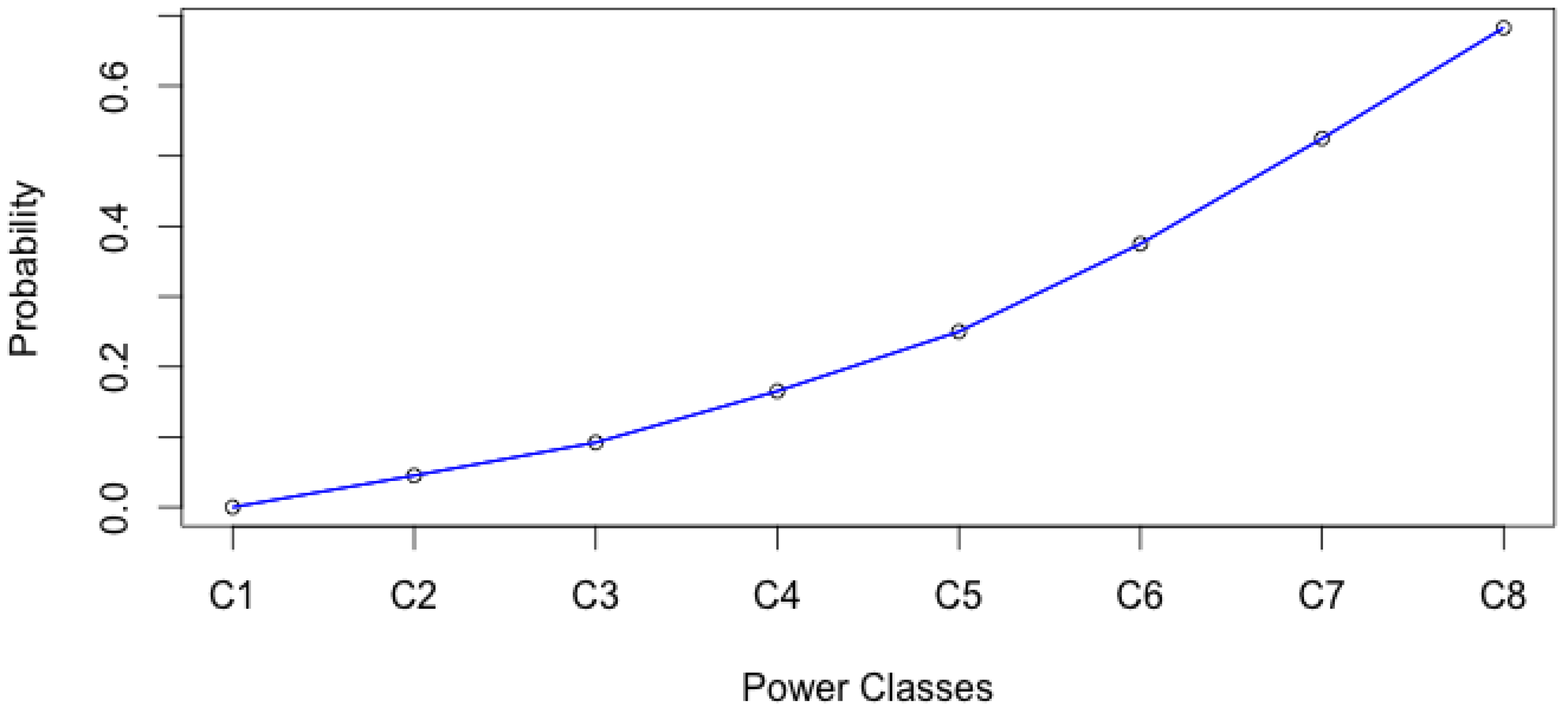
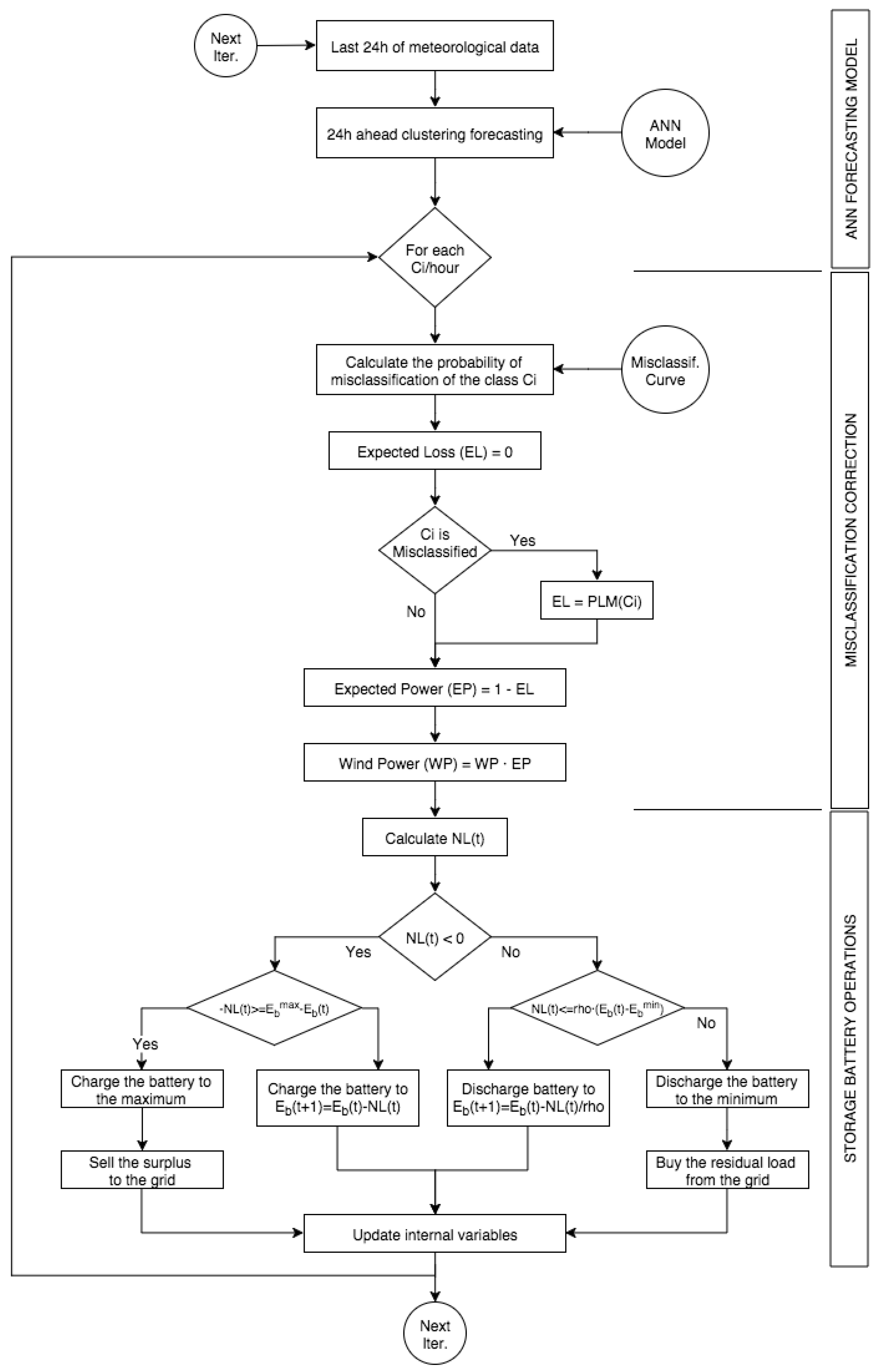
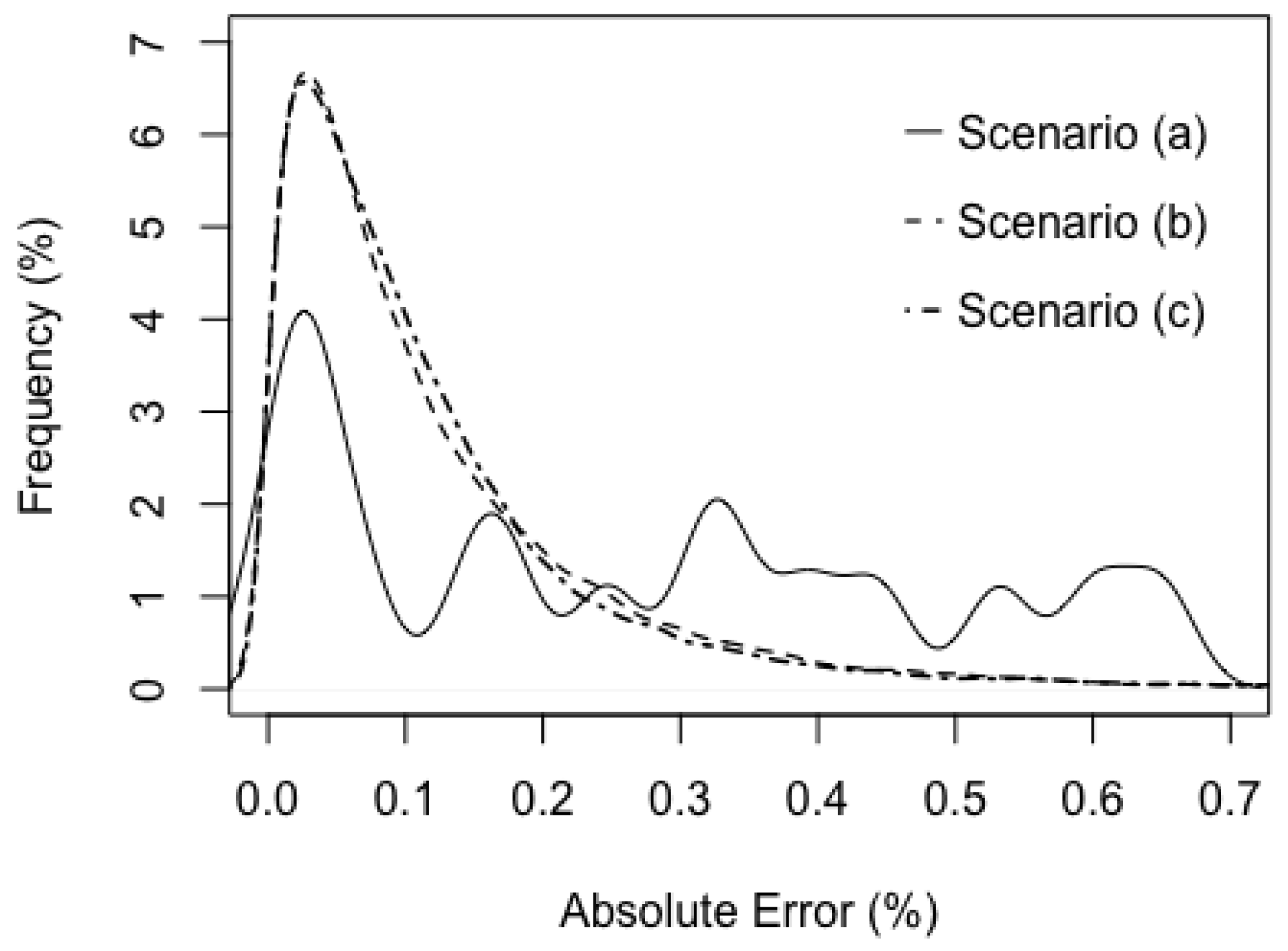
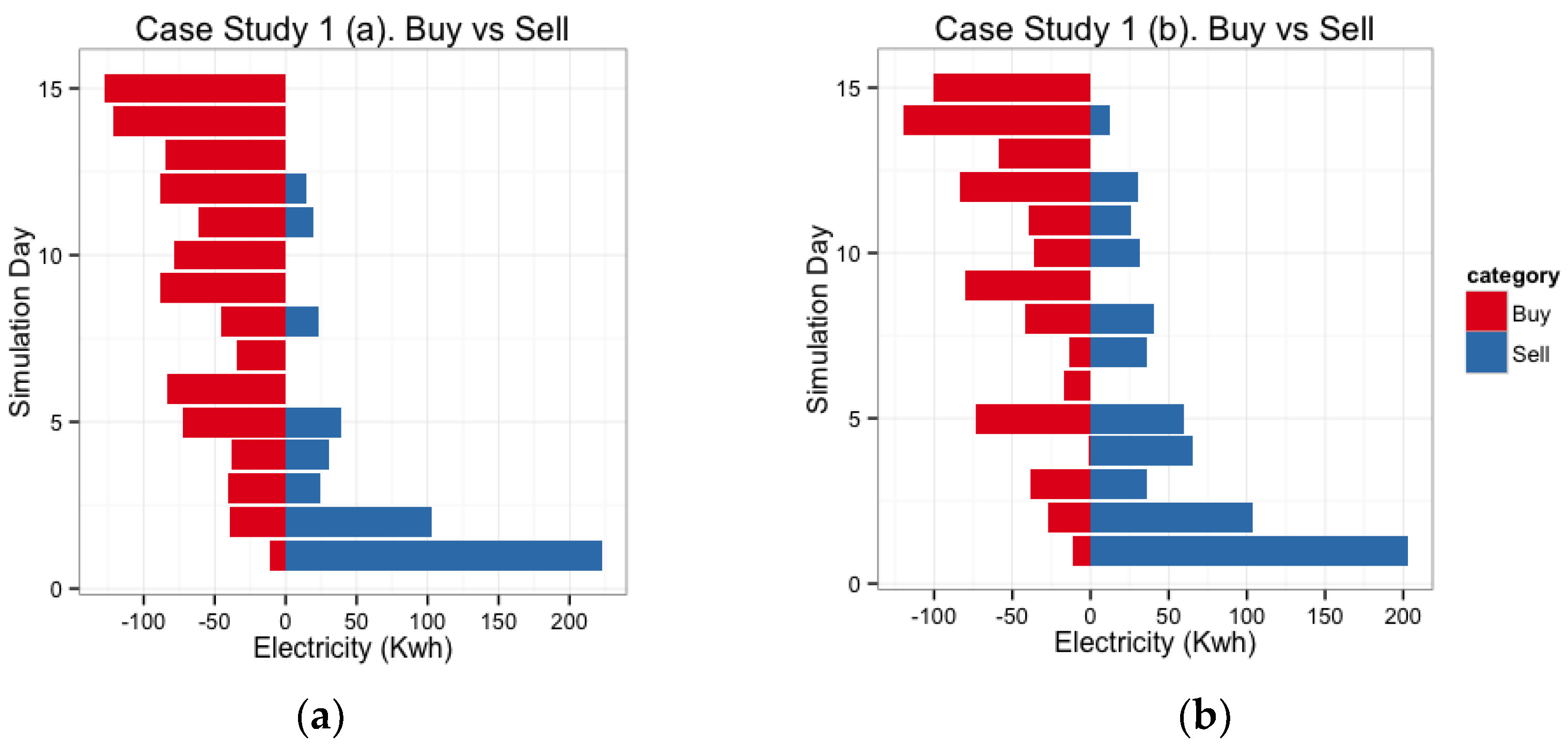

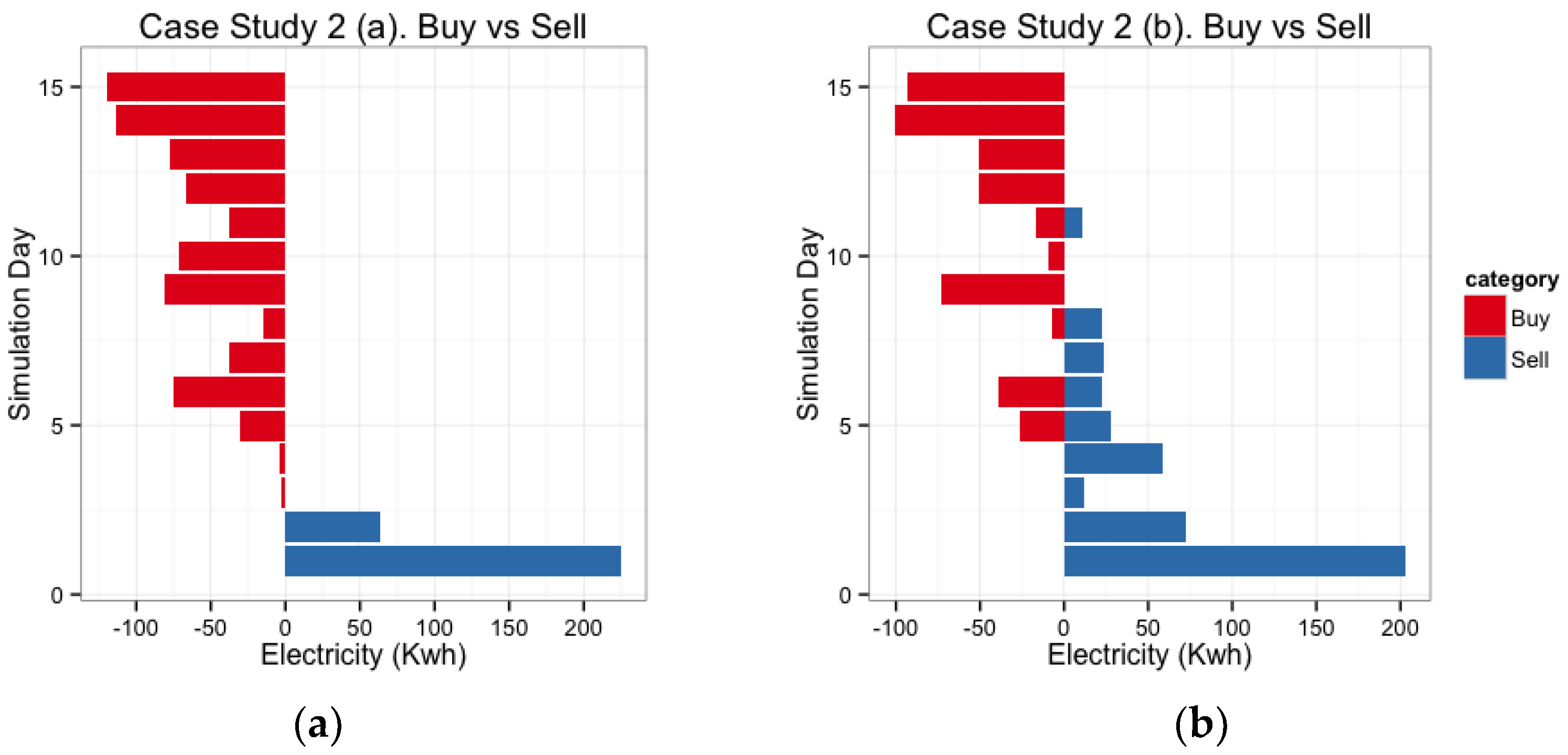
| Description | Specification |
|---|---|
| Configuration | 3 blades, horizontal axis |
| Rotor diameter | Φ 8.0 m |
| Rated power | 11 kW @ 11 m/s |
| Cut-in wind speed | 3 m/s |
| Cut-off wind speed | 25 m/s |
| Generator efficiency | >0.85 |
| Battery bank voltage | 240 Vdc |
| System output voltage | 110/220 Vac |
| Wind energy utilizing ratio (Cp) | 0.40 |
| Battery voltage | 24 V |
| Battery capacity | 150 Ah |
| Minimum discharge level | 30% |
| Maximum charge level | 100% |
| Battery discharge efficiency | 0.8 |
| Battery charge efficiency | 0.8 |
| Parameter | Value |
|---|---|
| Number of iterations | 10.000 |
| Simulated days | 15 |
| Initial level of battery SoC | 80% |
| Pre-negotiated electricity price: grid to building (G2B) | 0.2 €/kWh |
| Penalized price G2B | 0.3 €/kWh |
| Electricity price: building to grid (B2G) | 0.15 €/kWh |
| Variable | Scenario | Minimum | 1st Quartile | 2nd Quartile | Mean | 3rd Quartile | Maximum |
|---|---|---|---|---|---|---|---|
| Electricity purchased (kWh) | (a) | 10.60 | 38.30 | 72.27 | 67.59 | 87.61 | 127.60 |
| (b) | 0.35 | 20.60 | 40.77 | 49.44 | 49.48 | 141.30 | |
| (c) | 0.35 | 25.21 | 41.24 | 50.46 | 79.48 | 135.50 | |
| Electricity sold (kWh) | (a) | 0.00 | 0.00 | 15.11 | 31.97 | 31.33 | 234.20 |
| (b) | 0.00 | 0.00 | 32.57 | 42.89 | 55.92 | 223.30 | |
| (c) | 0.00 | 0.00 | 31.47 | 39.01 | 50.54 | 218.10 | |
| Net profit (€) | (a) | −25.54 | −16.97 | −10.90 | −9.39 | −6.03 | 33.01 |
| (b) | −28.25 | −12.26 | −3.26 | −3.70 | 2.11 | 30.28 | |
| (c) | −27.09 | −12.42 | −4.01 | −4.46 | 1.17 | 30.23 | |
| Battery charge (Ah) | (a) | 444.11 | 489.04 | 566.24 | 583.25 | 647.91 | 947.83 |
| (b) | 338.77 | 538.15 | 645.38 | 641.91 | 703.41 | 947.89 | |
| (c) | 345.76 | 534.44 | 638.66 | 635.49 | 702.72 | 939.91 |
| Hour | Daily Load (kWh) | Hour | Daily Load (kWh) | Hour | Daily Load (kWh) |
|---|---|---|---|---|---|
| 1 | 6 | 9 | 6 | 17 | 6 |
| 2 | 3 | 10 | 7 | 18 | 10 |
| 3 | 2 | 11 | 8 | 19 | 12 |
| 4 | 2 | 12 | 9 | 20 | 17 |
| 5 | 2 | 13 | 15 | 21 | 13 |
| 6 | 2 | 14 | 17 | 22 | 12 |
| 7 | 2 | 15 | 12 | 23 | 11 |
| 8 | 5 | 16 | 8 | 24 | 9 |
| Variable | Scenario | Minimum | 1st Quartile | 2nd Quartile | Mean | 3rd Quartile | Maximum |
|---|---|---|---|---|---|---|---|
| Electricity purchased (kWh) | (a) | 0.00 | 3.62 | 38.13 | 49.10 | 77.79 | 120.50 |
| (b) | 0.00 | 0.00 | 16.67 | 31.21 | 50.29 | 128.20 | |
| (c) | 0.00 | 0.00 | 19.79 | 31.70 | 51.38 | 132.50 | |
| Electricity sold (kWh) | (a) | 0.00 | 0.00 | 0.00 | 19.19 | 0.00 | 233.40 |
| (b) | 0.00 | 0.00 | 13.37 | 30.24 | 29.12 | 231.80 | |
| (c) | 0.00 | 0.00 | 10.58 | 25.38 | 27.17 | 223.70 | |
| Net profit (€) | (a) | −24.11 | −15.56 | −9.19 | −7.61 | −2.12 | 35.00 |
| (b) | −25.63 | −10.39 | −1.31 | −1.95 | 2.92 | 33.80 | |
| (c) | −26.50 | −10.62 | −1.53 | −2.76 | 2.23 | 33.55 | |
| Battery charge (Ah) | (a) | 315.0 | 315.0 | 320.4 | 448.7 | 501.9 | 1003.0 |
| (b) | 315.0 | 317.5 | 630.2 | 649.6 | 960.7 | 1013.0 | |
| (c) | 315.0 | 317.2 | 627.3 | 637.7 | 944.8 | 1013.0 |
© 2017 by the authors. Licensee MDPI, Basel, Switzerland. This article is an open access article distributed under the terms and conditions of the Creative Commons Attribution (CC BY) license (http://creativecommons.org/licenses/by/4.0/).
Share and Cite
Genikomsakis, K.N.; Lopez, S.; Dallas, P.I.; Ioakimidis, C.S. Simulation of Wind-Battery Microgrid Based on Short-Term Wind Power Forecasting. Appl. Sci. 2017, 7, 1142. https://doi.org/10.3390/app7111142
Genikomsakis KN, Lopez S, Dallas PI, Ioakimidis CS. Simulation of Wind-Battery Microgrid Based on Short-Term Wind Power Forecasting. Applied Sciences. 2017; 7(11):1142. https://doi.org/10.3390/app7111142
Chicago/Turabian StyleGenikomsakis, Konstantinos N., Sergio Lopez, Panagiotis I. Dallas, and Christos S. Ioakimidis. 2017. "Simulation of Wind-Battery Microgrid Based on Short-Term Wind Power Forecasting" Applied Sciences 7, no. 11: 1142. https://doi.org/10.3390/app7111142





